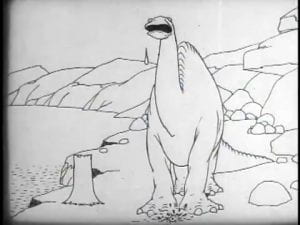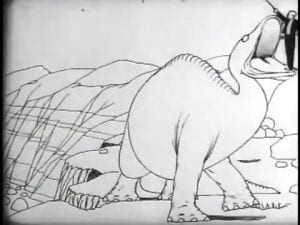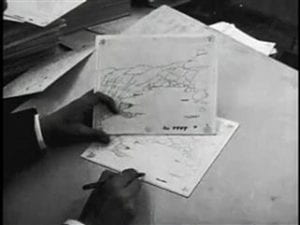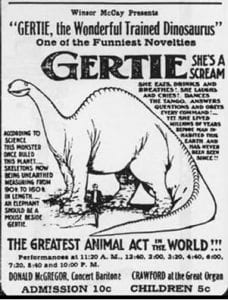 On 8th February, 1914, a new vaudeville opened in Chicago’s Palace Theatre. Vaudeville was a popular stage entertainment, by various performers performing novelty acts – singing, dancing, juggling, performing acrobatics.. but this act was different. Winsor McCay introduced his tame dinosaur, Gertie, to the world.
On 8th February, 1914, a new vaudeville opened in Chicago’s Palace Theatre. Vaudeville was a popular stage entertainment, by various performers performing novelty acts – singing, dancing, juggling, performing acrobatics.. but this act was different. Winsor McCay introduced his tame dinosaur, Gertie, to the world.
McCay had created a 7-minute hand drawn cartoon of a sauropod dinosaur, based on the Brontosaurus skeleton that had been displayed in the American Museum of Natural History in New York since 1905. The cartoon was projected onto a screen on the stage, and Gertie seemed to interact with him as, in the manner of a circus ringmaster, he gave her different commands.
Gertie was the first animated character to have her own personality, and McCay had worked out the animation techniques from first principles, working with an assistant, John Fitzsimmons, to create between 6,000 and 7,000 drawings by hand.
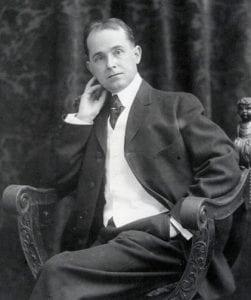 So who was Winsor McCay? He was a newspaper illustrator and comic strip artist working for various newspapers, including newspaper magnate William Hearst’s New York Herald. He was well-known among readers for his weekly comic strips including Little Nemo in Slumberland and Dream of the Rarebit Fiend, yet in 1906, he started to appear in vaudeville, performing lightning sketches, drawing ‘live’ on stage. But when his son brought a flip-book home from school he began to consider the idea of animating drawings to create movement. McCay had made two animations before Gertie, but Gertie was so successful his employer, Hearst, stopped his vaudeville performances. So McCay made the act into a film with a live-action beginning and end, and this film is still viewable – see link below.
So who was Winsor McCay? He was a newspaper illustrator and comic strip artist working for various newspapers, including newspaper magnate William Hearst’s New York Herald. He was well-known among readers for his weekly comic strips including Little Nemo in Slumberland and Dream of the Rarebit Fiend, yet in 1906, he started to appear in vaudeville, performing lightning sketches, drawing ‘live’ on stage. But when his son brought a flip-book home from school he began to consider the idea of animating drawings to create movement. McCay had made two animations before Gertie, but Gertie was so successful his employer, Hearst, stopped his vaudeville performances. So McCay made the act into a film with a live-action beginning and end, and this film is still viewable – see link below.
Gertie was innovative for several reasons.
 The cartoon is a simple line drawing set in a fixed, static landscape, and McCay creates a sense of depth by his superb use of perspective. He implied Gertie’s weight and size by her picking up and eating a rock and a tree. She meets a character he calls ‘Jumbo’, based on the famous PT Barnum elephant, but drawn looking more like a mammoth than an elephant.
The cartoon is a simple line drawing set in a fixed, static landscape, and McCay creates a sense of depth by his superb use of perspective. He implied Gertie’s weight and size by her picking up and eating a rock and a tree. She meets a character he calls ‘Jumbo’, based on the famous PT Barnum elephant, but drawn looking more like a mammoth than an elephant.
Like a ‘tame’ wild circus animal, Gertie doesn’t always obey McCay and even snaps at him, but when he scolds her, she bursts into floods of tears. She throws Jumbo into the lake, and with brilliant timing, while she is dancing on her hind legs, Jumbo squirts water at her in revenge.
McCay interacts directly with his screen dinosaur – he appears to throw her an apple but using sleight of hand, he pockets the apple as it appears on screen and she catches it. As a finale, he walks behind the screen and she picks him up, carrying him out of frame.. to thunderous applause.
McCay was, first and foremost, an entertainer, and Gertie was a comedy act, yet she is one of the most famous individual dinosaurs in the history of palaeomedia. She is endearing, funny, and McCay had more than likely consulted the work of Eadweard Muybridge (who had created photographic sequences of animals walking and running) to work out her walk cycle. He had invented the idea of ‘cycles’ so that repetitive movement such as her dance could be photographed and repeated. He created the principle of the ‘key frame’ and the idea that a less experienced animator, an ‘in-betweener’ could be used to complete the intermediate drawings.
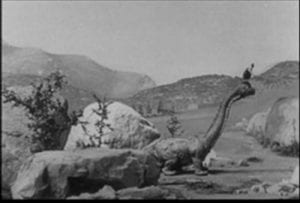 The young Buster Keaton was transfixed by the pet dinosaur. When making his 1923 film The Three Ages, he had asked his writer: “Remember Gertie the Dinosaur? . . . The first cartoon comedy ever made. I saw it in a nickelodeon when I was fourteen [sic; he was at least nineteen]. I’ll ride in on an animated cartoon.” When he appears as a caveman, clay models were used to show him riding on the back of dinosaur that had a close resemblance to Gertie.
The young Buster Keaton was transfixed by the pet dinosaur. When making his 1923 film The Three Ages, he had asked his writer: “Remember Gertie the Dinosaur? . . . The first cartoon comedy ever made. I saw it in a nickelodeon when I was fourteen [sic; he was at least nineteen]. I’ll ride in on an animated cartoon.” When he appears as a caveman, clay models were used to show him riding on the back of dinosaur that had a close resemblance to Gertie.
Winsor McCay died suddenly, aged 62, in 1934, of a massive cerebral haemorrhage.
Gertie certainly influenced Walt Disney, and although it isn’t clear whether Disney saw the original performance, he always acknowledged McCay’s contribution to animation technique. Chuck Jones, the director of Warner Brothers cartoons, creator of Coyote and Roadrunner and Bugs Bunny, to name but a few, wrote in 1989:
It is as though the first creature to emerge from the primeval slime was Albert Einstein; and the second was an amoeba, because after McCay’s animation it took his followers nearly twenty years to find out how he did it. The two most important people in animation are Winsor McCay and Walt Disney, and I’m not sure which should go first.
The film can be streamed or downloaded here.


